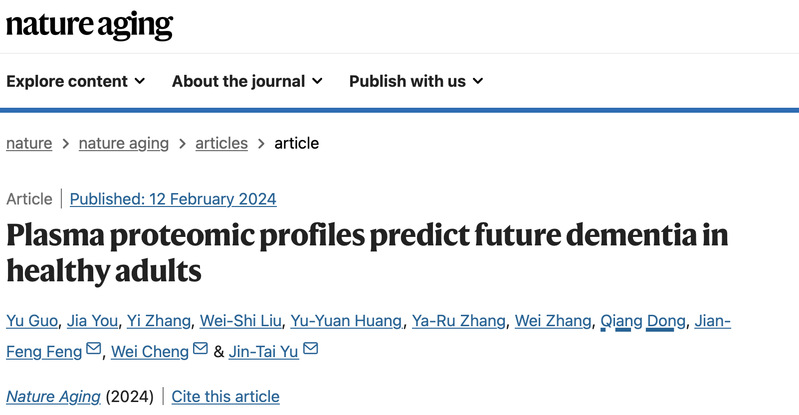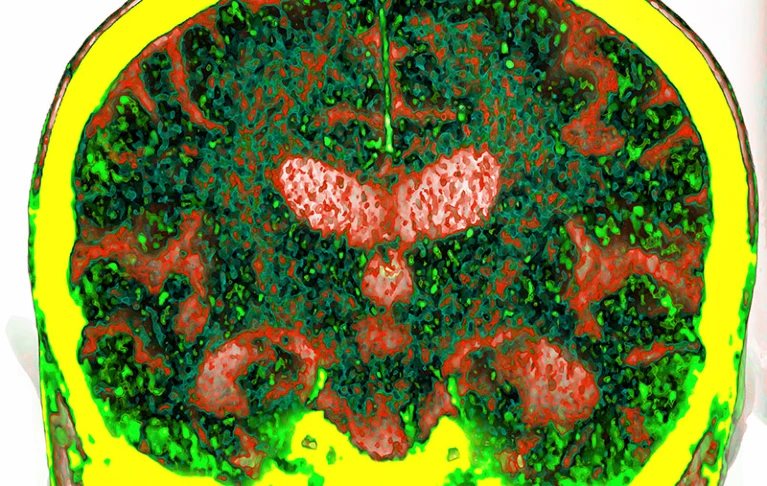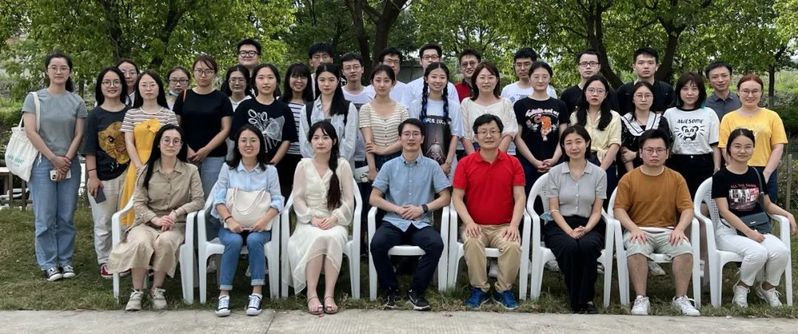Can you imagine predicting the likelihood of dementia with just a drop of blood? By analyzing plasma proteins, scientists can forecast dementia risks up to 15 years in advance. Hopefully, such implications could allow individuals to access the dementia risk directly from their blood test results in the near future.

On February 13, a research was published in Nature Aging entitled “Plasma proteomic profiles predict future dementia in healthy adults”.

Nature, in its editorial article “Early dementia diagnosis: blood proteins reveal at-risk people”, stated this work as “a step towards a tool that scientists have been in search of for decades: blood tests that can detect Alzheimer’s disease and other forms of dementia at a very early, pre-symptomatic stage.”
Incorporating machine learning approaches, this study explored 1463 plasma proteins to identify key biomarkers capable of predicting dementia 15 years before diagnosis. This breakthrough offers the potential for early intervention and treatment of the disease.
AI facilitates early detection of brain disorders
According to the World Health Organization, dementia affects over 55 million individuals globally, and this number is expected to rise significantly in the coming years.
Dementia progresses slowly from the asymptomatic stage to a fully expressed clinical syndrome over many years, usually lasting over a decade or more. “By the time patients present with cognitive behavioral disorders, it might be too late that the disease grows up to the middle or late stages, and the best period of intervention is missed.” said co-author Prof. Jianfeng Feng, a computational biologist from Fudan University.
Leveraging the largest community-based cohort of blood proteomics and dementia to date, scientists from Fudan University unveiled significant associations of GFAP, NEFL, and GDF15 with the risk of incident dementia, including all-cause dementia (ACD), Alzheimer’s disease (AD), and vascular dementia (VaD). Additionally, LTBP2 also emerged close relationship with dementia onset. These biomarkers, incorporating conventional risk factors of age, sex, education level and genetics, for the first time yielded the high accuracy of the predictive model, measured at over 90%*.
“Our study provides a great example of how AI can facilitate a research paradigm that fosters interdisciplinary collaboration. Employing machine learning, we extracted and optimized the combinations using a large-scale dataset and established a protein-based dementia prediction model with high accuracy,” explained Prof. Feng. Unlike previous studies that relied on small sample sizes and cross-sectional designs, the Fudan team utilized large-scale, longitudinal data spanning a long period of time. This approach allowed them to extract insightful patterns, trends, and associative information, emphasizing the importance of letting the data “speak”.
To further improve the accuracy of the prediction, the scientists transformed the protein screening process into mathematical algorithms of combinatorial optimization. The proteins were fed into a preliminary trained light gradient boosting machine classifier and ranked according to their contribution to model performance (as judged by the information gain). Afterward, a sequential forward selection approach was employed, adding proteins into the newly developed LGBM classifier one at a time in succession based on their ranking of importance. In this way, a set of proteins that were most important for the prediction of dementia were successfully identified. Such algorithms take into account not only the role of individual proteins, but also the interactions and synergies between proteins, allowing for more accurate predictions.
Lower cost, less invasiveness and higher precision
“Diagnosing brain disorders is often difficult. Lumbar punctures are invasive, imaging examinations are expensive, and the clinical implementation of such technologies faces constraints such as facility availability, limiting their widespread application in real settings. In contrast, blood tests are convenient, non-invasive, and cost-effective, making them a preferable tool to facilitate early risk screening in the preclinical phase among the general population,” Cheng explained. “With our team’s discovery of the link between proteomics and brain disease risk, blood tests are expected to assist clinicians in identifying people at high risk of dementia as early as possible, enabling timely intervention and improving patients’ quality of life.”
“The important plasma biomarkers we identified provide a new theoretical basis for the transition of blood testing from scientific research to clinical practice. Moreover, the blood markers we unveiled are easily accessible and popularize, which are capable of predicting future dementia risks with high accuracies in both short- and long-terms,” Prof. Yu said.
Blood testing is expected to enter clinical application in the next six months
If all goes well, blood testing is expected to be applied in real clinical settings within the next six months to screen high-risk populations. The early detection of disease opens an door to early intervention, offering the potential to slow down or even halt the progression of the disease.
The research team shared that some medical institutions have taken the initiative to contact them to explore the possibility of incorporating blood tests into their health-check programs. Moving forward, the team will focus on conducting data collection and cross-validation among populations at risk of dementia in China. They will tailor the dementia risk prediction model to fit the characteristics of the Chinese population by adjusting relevant data.
The interdisciplinary team of Fudan University, composed of top experts in artificial intelligence, neuroscience and neurology, began their collaborations in 2021, and has jointly published over ten top articles in corresponding fields. The prediction model they previously built could predict the risk of dementia onset ten years in advance, with a discriminative accuracy of 85%*. In this latest study, the prediction window has been advanced to fifteen years before dementia onset, with an accuracy exceeding 90%*.

The paper’s co-first authors include Yu Guo, a PhD candidate at Huashan Hospital, Fudan University, Jia You, a postdoctoral fellow at the Institute of Science and Technology for Brain-inspired Intelligence, Fudan University, and Yi Zhang, a PhD candidate at Huashan Hospital, Fudan University. Co-corresponding authors are Professor Jian-Feng Feng and Professor Wei Cheng from the Institute of Science and Technology for Brain-inspired Intelligence, Fudan University, along with Professor Jin-Tai Yu from Huashan Hospital, Fudan University.
*Discriminative accuracy defined using Area Under the ROC Curve (AUC), a metric used to evaluate the performance of the classification model. An AUC of 0.0 indicates the predictions are 100% wrong, while an AUC of 1.0 indicates the predictions are 100% correct. This study had an AUC of over 0.9.
(END)
Presented by Fudan University Media Center
Writer: Chen Shuyang
Editor: Li Yijie, Wang Mengqi





